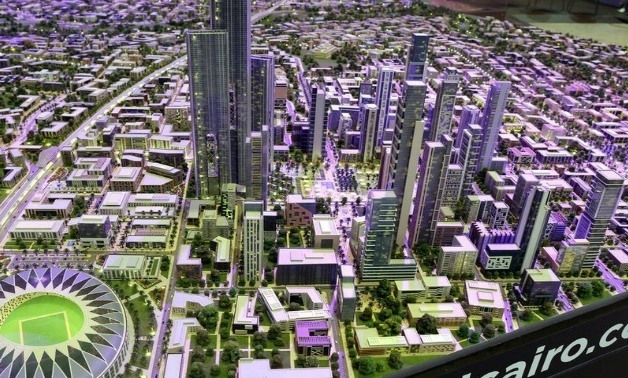
New Administrative Capital model - File Photo
CAIRO – 14 January 2018: A residential area will be built in the New Administrative Capital for 35,000 state employees whose work will be transferred there; in addition to six schools and six universities, spokesperson of the Ministry of Housing, Utilities, and Urban Development HanyYounes said on Sunday.
Egypt celebrated the launching of the first phase of the New Administrative Capital on October 11, 2017, at the newly inaugurated Al-Masah Capital Hotel. Egyptian President Abdel Fatah al-Sisi has inaugurated the opening ceremony alongside Prime Minister Sherif Ismail.
“It is too early to say we achieved something… this is only the first step,” Sisi said; noting that the New Administrative Capital will be registered in history as a major achievement and a turning point in Egypt’s development.
Head of the Armed Forces’ Engineering Authority Kamilel-Wazir said during the opening ceremony that the authority started working on the project in July 2016.
“We were assigned to work on the government district, which will spread over 1,133 feddans and will include buildings of ministries and the parliament,” Wazir said; adding that they are working on the residential district, the New Capital Airport, universities and a network of roads and tunnels.
The New Administrative Capital is the government’s ambitious means of expanding urban development in Cairo and accommodating the rising population of Egypt. The project has been announced in 2015 and is being developed by the New Administrative Capital for Urban Development.
The project’s first phase is worth a total of $8 billion and spans over 12,500 feddans, featuring 25,000 residential units and infrastructure projects, according to the Minister of Housing and Urban Communities MostafaMadbouly.
Approximately 96 kilometers of roads, water supply, rural sanitation projects, and irrigation systems will be included in the same phase, and they will be constructed by 17 contractors.
The entire project features a total of 20 residential neighborhoods worth $15 billion, eight of which will be built in the first phase. The residential areas in the project will include an array of accommodation units including apartments, villas, town houses, office spaces and commercial units.
The Egyptian government has created a master plan for the New Administrative Capital City which is supposed to include residential districts, educational facilities, hospitals, 40,000 hotel rooms, a theme park, solar panels, and an international airport; making it a local and regional investment hub.
The government has offered several land plots in the mega project to developers and investors earlier this year to include active agents in the developments such as the Arab Contractors, Concord for Engineering and Contracting, and TalaatMostafa Group Holding Company.
Considered one of the world’s largest hotels, Al-Masah Capital Hotel has been opened last Friday. It spans over 10 acres of land and features a conference area, a mosque, a mall, and several lakes.
The project features 20 towers including the tallest tower in Africa that will have a height of 345 meters, according to Madbouly’s statement.
CEO of the New Administrative Capital for Urban Development Company, Ayman Ismail, has stated earlier at the Euromoney Conference, which was held in September, that the mega project is meant to feature mixed-use developments accompanied by a full transportation scheme.
Ismail has spoken during the conference about the benefits of building mixed-use developments, serving larger numbers of the Egyptian citizens; elaborating that the company'splan to expand urban developmentwas the main path for accommodating the growing population of Cairo, amounting to morethan 20 million citizens.He strictly emphasized that the project is not a replacement for the actual capital of Cairo but is a further expansion to it, and that it will not operate in the same manner of therecent developments in areas like New Cairo and 6th of October City.
“Cairo is facing a challenge with government institutions and offices being centered in downtown, and the plan here is to relocate these offices to the ‘government district’,while also serving an economic purpose of acquiring revenues worth $10 billion by 2030, and being in proximity to Cairo and the SCZone,” Ismail explained.
Ismail added that the government district will be finalized by 2018, and state institutions will be relocatedto the district by2019.
The project is also meant to tackle the housing gap found in the middle-income socioeconomic class, which Ismail has considered a challengingmatter due to the current economic conditions resulting from inflation. However, he mentioned that there are several land offerings in the upcoming period that will be provided through feasible agreements with end-users.
Ismail also spoke about the strategies carried out to finance the mega project which included creating a shareholder company that owns assets of the project including lands. The capital also comes from the New Urban Communities Authority (NUCA) and the Egyptian military force.
Among the upcoming plans within the project is Sisi's anticipated contract with China Electronic System Engineering Company to buildabusiness park. Other plans include the construction of an electric train that will move from Salam City to the New Capital.
Contractors will also begin the construction of the 25,400 units that commenced last May; which range from apartments, villas, and commercial units; to 650-kilometer road networks, wide streets, green spaces, water treatment plants and cultural hubs.

Comments
Leave a Comment